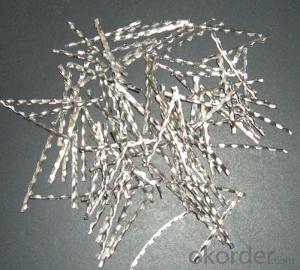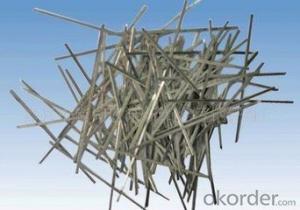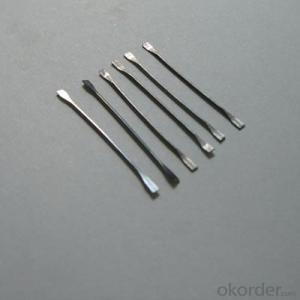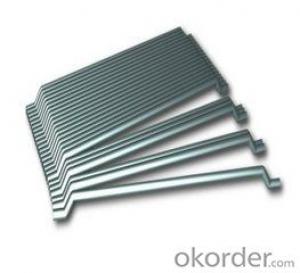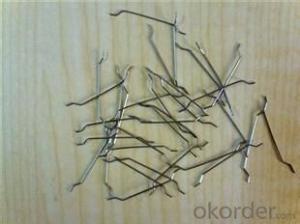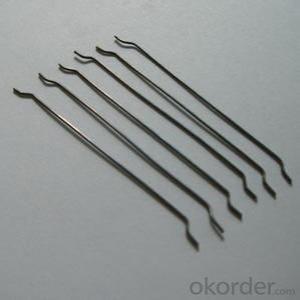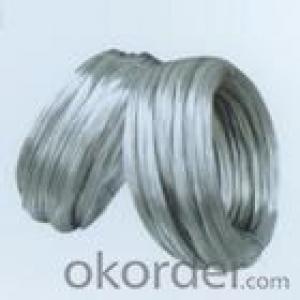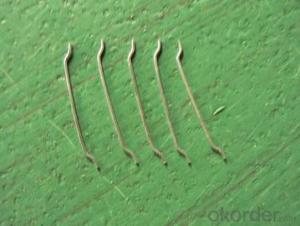Steel Fiber Straight Type CNBM International China
- Loading Port:
- Tianjin
- Payment Terms:
- TT OR LC
- Min Order Qty:
- 1000 kg
- Supply Capability:
- 30000 kg/month
OKorder Service Pledge
OKorder Financial Service
You Might Also Like
Quick Details
Place of Origin: Jiangsu, China (Mainland)
Model Number: HT-ST
Material: Steel
Specifications
The raw material is stainless steel ingots, using electric stoves which melt the stainless steel ingots to become 1500 ~ 1600 ℃ steel liquid, and then with a grooved high speed rotating melt-extracting steel wheel which produces wires that meets are our customers’ specific requirements. When melting down to a wheel steel liquid surface, the liquid steel blow out by slot with centrifugal force at extremely high speed with cooling forming. Melting wheels with water keep the cooling speed. This method is done to produce different material, different sizes of steel fiber.
| SIZE | CHEMIC ELEMENT(%) | ||||||
| C | P | Mn | Si | Cr | Ni | Al | |
| AISI330 | ≤0.40 | ≤0.04 | ≤2.00 | ≤0.75 | 17~20 | 33~37 | |
| AISI310 | ≤0.40 | ≤0.04 | ≤2.00 | ≤1.50 | 24~26 | 19~22 | |
| AISI316 | ≤0.40 | ≤0.04 | ≤2.00 | ≤1.00 | 16~18 | 10~14 | |
| AISI314 | ≤0.40 | ≤0.045 | ≤2.00 | 1.5-3.0 | 23~26 | 19~22 | |
| AISI309 | ≤0.40 | ≤0.04 | ≤2.00 | ≤1.00 | 22~24 | 12~15 | |
| AISI304 | ≤0.40 | ≤0.04 | ≤2.00 | ≤2.00 | 18~20 | 8~10 | |
| AISI301 | ≤0.40 | ≤0.04 | ≤2.00 | ≤2.00 | 16~18 | 6~8 | |
| AISI201 | ≤0.40 | ≤0.06 | 5.5~7.5 | ≤1.00 | 16~18 | 3.5~5.5 | |
| AISI446 | ≤0.40 | ≤0.04 | ≤1.50 | ≤2.00 | 23~27 | ||
| AISI430 | ≤0.40 | ≤0.03 | ≤1.00 | ≤2.00 | 16~18 | ||
| NAS430A | ≤0.40 | ≤0.03 | ≤0.50 | ≤0.50 | 16~18 | 2~4 | |
| SIZE(mm) | ||||
| length | 20 | 25 | 30 | 35 |
| width | 0.75~1.5 | 0.75~1.5 | 0.75~1.5 | 0.75~1.5 |
| thickness | 0.2~0.75 | 0.2~0.75 | 0.2~0.75 | 0.2~0.75 |
Picture
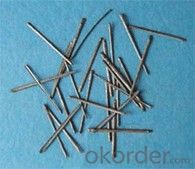
Steel fiber straight type


FAQ
certificated: ISO 9001
Technical advantages of Daye steel fiber:
A. Improve mechanical performance of concrete
B. Provide uniform distribution throughout concrete with excellent mixing
C. No balling or caking by adopt correct mixing method
- Q:Is melt extract stainless steel fiber compatible with all types of aggregate?
- No, melt extract stainless steel fiber may not be compatible with all types of aggregate. The compatibility depends on various factors such as the size, shape, and composition of the aggregate, as well as the specific application requirements. It is important to consider consulting with experts or conducting tests to determine the compatibility before using melt extract stainless steel fiber with a particular type of aggregate.
- Q:Can melt extract stainless steel fiber be used in high-strength concrete mixtures?
- Yes, melt extract stainless steel fiber can be used in high-strength concrete mixtures. The addition of stainless steel fibers enhances the tensile strength and durability of the concrete, making it suitable for applications where high-strength is required, such as in construction projects or infrastructure projects.
- Q:How does the addition of melt extract stainless steel fiber impact the flowability of concrete?
- Adding melt extract stainless steel fiber to concrete can have a significant effect on its flowability. Typically, stainless steel fibers are incorporated into concrete to enhance its mechanical properties, including increasing its tensile and flexural strength, improving its durability, and reducing cracking. Nevertheless, the inclusion of stainless steel fibers can also influence the flowability of the concrete mixture. The presence of fibers can raise its viscosity, making it more resistant to flow. This effect is particularly prominent in concrete mixtures with a high volume of fibers. The flowability of concrete is commonly evaluated using the slump test, which measures its consistency and workability. When stainless steel fibers are added, the slump of the concrete can decrease, indicating a decrease in flowability. However, the impact of stainless steel fibers on flowability can be managed and controlled through appropriate mix design and dosage. By adjusting factors such as the fiber content, size, and shape of the fibers, as well as the water-to-cement ratio, the flowability of the concrete can be optimized to meet the specific project requirements. In summary, incorporating melt extract stainless steel fibers can noticeably affect the flowability of concrete. Nevertheless, by employing proper mix design and dosage, the flowability can be regulated and tailored to achieve the desired performance characteristics of the concrete.
- Q:What is the effect of melt extract stainless steel fiber on the thermal conductivity of concrete?
- The inclusion of melt extract stainless steel fiber in concrete can significantly improve the thermal conductivity of the material. Stainless steel fibers have excellent thermal conductivity properties, meaning they can efficiently transfer heat throughout the concrete. When these fibers are added to the concrete mix, they form a three-dimensional network that helps to conduct and distribute heat more effectively. This enhanced thermal conductivity can have several positive effects on the concrete's performance. Firstly, the increased thermal conductivity can improve the overall thermal efficiency of structures built with this type of concrete. It allows for better heat transfer, which can help regulate temperatures more efficiently, reducing the need for additional insulation or heating and cooling systems. Additionally, the improved thermal conductivity can also enhance the durability of the concrete. By evenly distributing heat and minimizing temperature gradients, the risk of thermal cracking and damage due to thermal expansion and contraction is reduced. This is especially beneficial in environments with significant temperature variations. Moreover, the higher thermal conductivity provided by melt extract stainless steel fiber can also be advantageous in applications such as radiant floor heating systems. The fibers can efficiently transfer heat from the heating elements to the surface, resulting in more efficient and effective heating. In summary, the inclusion of melt extract stainless steel fiber in concrete significantly enhances its thermal conductivity. This improvement can lead to increased thermal efficiency, improved durability, and better performance in various applications where heat transfer is a critical factor.
- Q:Can melt extract stainless steel fiber be used in pre-stressed or post-tensioned concrete?
- Yes, melt extract stainless steel fiber can be used in pre-stressed or post-tensioned concrete. The high tensile strength and durability of stainless steel fibers make them suitable for these applications, as they can enhance the overall strength and performance of the concrete.
- Q:Can melt extract stainless steel fiber be used in the construction of offshore platforms?
- Melt extract stainless steel fiber is indeed a viable option for the construction of offshore platforms. This material possesses exceptional strength and outstanding resistance to corrosion, which makes it highly suitable for marine environments like offshore platforms. By incorporating it into concrete reinforcement, the structural integrity and durability of the platform can be greatly enhanced. The stainless steel fiber's capacity to withstand harsh conditions, such as exposure to saltwater, ensures the long-lasting and robust nature of the offshore platform. Moreover, utilizing stainless steel fiber can aid in minimizing the expenses related to maintenance and repair caused by corrosion damage, thus establishing it as an ideal choice for constructing offshore platforms.
- Q:Can melt extract stainless steel fiber be used in concrete bridge decks?
- Yes, melt extract stainless steel fiber can be used in concrete bridge decks. Stainless steel fibers are commonly used as reinforcement in concrete structures, including bridge decks. These fibers improve the overall strength and durability of the concrete, enhancing its resistance to cracking and increasing its load-bearing capacity. Melt extract stainless steel fibers are known for their high tensile strength and corrosion resistance, making them an excellent choice for bridge decks exposed to harsh environmental conditions. Additionally, these fibers can help control shrinkage and prevent the formation of cracks, enhancing the long-term performance and service life of the bridge decks. Overall, melt extract stainless steel fiber is a suitable and beneficial reinforcement option for concrete bridge decks.
- Q:What are the applications of melt extract stainless steel fiber?
- Melt extract stainless steel fibers have various applications in different industries. They are commonly used in concrete reinforcement to enhance the durability and strength of structures like bridges and pavements. These fibers also find application in high-temperature insulation materials, as they can withstand extreme temperatures and provide thermal resistance. Additionally, melt extract stainless steel fibers are used in the production of friction materials, such as brake pads, to improve their wear resistance and performance. Overall, these fibers offer excellent mechanical properties, corrosion resistance, and thermal stability, making them suitable for a wide range of applications.
- Q:What is the effect of melt extract stainless steel fiber on the workability of concrete?
- The workability of concrete can be significantly influenced by the addition of melt extract stainless steel fiber. In order to enhance its mechanical properties and resistance to cracking, impact, and abrasion, stainless steel fibers are typically incorporated into concrete. One major advantage of utilizing stainless steel fiber in concrete is its ability to enhance tensile strength and flexural strength. This means that the concrete becomes more resistant to bending or cracking when under pressure, which is particularly crucial in structural applications. The inclusion of stainless steel fibers also improves the overall durability and long-term performance of the concrete. Nevertheless, the addition of stainless steel fibers can also have some drawbacks in terms of workability. The fibers can increase the viscosity of the concrete mix, thus making it more challenging to handle and place. As a result, the fluidity and cohesiveness of the mix may be compromised, making it more difficult to achieve the desired finish and surface texture. To overcome these challenges, it is crucial to carefully control the dosage and length of the stainless steel fibers used in the concrete mix. By optimizing the fiber content and distribution, it is possible to maintain a good balance between workability and the desired mechanical properties. In conclusion, the impact of melt extract stainless steel fiber on the workability of concrete involves a trade-off between improved mechanical properties and potential challenges in handling and placing the mix. With careful consideration of the fiber dosage and mix design, it is possible to achieve a concrete mix that provides both enhanced performance and satisfactory workability.
- Q:Are there any guidelines or standards for using melt extract stainless steel fiber in construction?
- Construction projects involving melt extract stainless steel fiber must adhere to guidelines and standards. ASTM A820 is the primary standard governing the use of stainless steel fiber in construction. This standard outlines guidelines for classifying, determining chemical composition, and assessing mechanical properties of stainless steel fibers used for concrete reinforcement. According to ASTM A820, stainless steel fibers must meet specific criteria for diameter, length, and tensile strength. The standard also specifies the minimum fiber content necessary to achieve the desired reinforcement effect when added to concrete. Aside from ASTM A820, other guidelines and standards exist for the usage of stainless steel fiber in specific applications. The American Concrete Institute (ACI), for example, provides recommendations for employing stainless steel fiber reinforcement in shotcrete and precast concrete elements. It is important to note that while these guidelines and standards offer valuable recommendations, they are not obligatory requirements. The specific requirements for utilizing melt extract stainless steel fiber in construction may differ depending on project specifications and local building codes. Consequently, consulting with design professionals and local authorities is always advisable to ensure compliance with the appropriate guidelines and standards.
1. Manufacturer Overview |
|
|---|---|
| Location | |
| Year Established | |
| Annual Output Value | |
| Main Markets | |
| Company Certifications | |
2. Manufacturer Certificates |
|
|---|---|
| a) Certification Name | |
| Range | |
| Reference | |
| Validity Period | |
3. Manufacturer Capability |
|
|---|---|
| a)Trade Capacity | |
| Nearest Port | |
| Export Percentage | |
| No.of Employees in Trade Department | |
| Language Spoken: | |
| b)Factory Information | |
| Factory Size: | |
| No. of Production Lines | |
| Contract Manufacturing | |
| Product Price Range | |
Send your message to us
Steel Fiber Straight Type CNBM International China
- Loading Port:
- Tianjin
- Payment Terms:
- TT OR LC
- Min Order Qty:
- 1000 kg
- Supply Capability:
- 30000 kg/month
OKorder Service Pledge
OKorder Financial Service
Similar products
New products
Hot products
Related keywords







